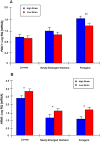PDK1 and HR46 gene homologs tie social behavior to ovary signals
- PMID: 19340296
- PMCID: PMC2659776
- DOI: 10.1371/journal.pone.0004899
PDK1 and HR46 gene homologs tie social behavior to ovary signals
Abstract
The genetic basis of division of labor in social insects is a central question in evolutionary and behavioral biology. The honey bee is a model for studying evolutionary behavioral genetics because of its well characterized age-correlated division of labor. After an initial period of within-nest tasks, 2-3 week-old worker bees begin foraging outside the nest. Individuals often specialize by biasing their foraging efforts toward collecting pollen or nectar. Efforts to explain the origins of foraging specialization suggest that division of labor between nectar and pollen foraging specialists is influenced by genes with effects on reproductive physiology. Quantitative trait loci (QTL) mapping of foraging behavior also reveals candidate genes for reproductive traits. Here, we address the linkage of reproductive anatomy to behavior, using backcross QTL analysis, behavioral and anatomical phenotyping, candidate gene expression studies, and backcross confirmation of gene-to-anatomical trait associations. Our data show for the first time that the activity of two positional candidate genes for behavior, PDK1 and HR46, have direct genetic relationships to ovary size, a central reproductive trait that correlates with the nectar and pollen foraging bias of workers. These findings implicate two genes that were not known previously to influence complex social behavior. Also, they outline how selection may have acted on gene networks that affect reproductive resource allocation and behavior to facilitate the evolution of social foraging in honey bees.
Conflict of interest statement
Figures





Similar articles
-
Sensory response system of social behavior tied to female reproductive traits.PLoS One. 2008;3(10):e3397. doi: 10.1371/journal.pone.0003397. Epub 2008 Oct 14. PLoS One. 2008. PMID: 18852894 Free PMC article.
-
Support for the reproductive ground plan hypothesis of social evolution and major QTL for ovary traits of Africanized worker honey bees (Apis mellifera L.).BMC Evol Biol. 2011 Apr 13;11:95. doi: 10.1186/1471-2148-11-95. BMC Evol Biol. 2011. PMID: 21489230 Free PMC article.
-
Tyramine and its receptor TYR1 linked behavior QTL to reproductive physiology in honey bee workers (Apis mellifera).J Insect Physiol. 2020 Oct;126:104093. doi: 10.1016/j.jinsphys.2020.104093. Epub 2020 Aug 4. J Insect Physiol. 2020. PMID: 32763247
-
8. The development and evolution of division of labor and foraging specialization in a social insect (Apis mellifera L.).Curr Top Dev Biol. 2006;74:253-86. doi: 10.1016/S0070-2153(06)74008-X. Curr Top Dev Biol. 2006. PMID: 16860670 Free PMC article. Review.
-
Behavioral genomics of honeybee foraging and nest defense.Naturwissenschaften. 2007 Apr;94(4):247-67. doi: 10.1007/s00114-006-0183-1. Epub 2006 Dec 15. Naturwissenschaften. 2007. PMID: 17171388 Free PMC article. Review.
Cited by
-
Evaluating the role of reproductive constraints in ant social evolution.Philos Trans R Soc Lond B Biol Sci. 2010 Feb 27;365(1540):617-30. doi: 10.1098/rstb.2009.0257. Philos Trans R Soc Lond B Biol Sci. 2010. PMID: 20083637 Free PMC article.
-
Core transcriptional signatures of phase change in the migratory locust.Protein Cell. 2019 Dec;10(12):883-901. doi: 10.1007/s13238-019-0648-6. Epub 2019 Jul 10. Protein Cell. 2019. PMID: 31292921 Free PMC article.
-
Sterol and lipid metabolism in bees.Metabolomics. 2023 Aug 29;19(9):78. doi: 10.1007/s11306-023-02039-1. Metabolomics. 2023. PMID: 37644282 Free PMC article. Review.
-
Insulin-like peptides (AmILP1 and AmILP2) differentially affect female caste development in the honey bee (Apis mellifera L.).J Exp Biol. 2013 Dec 1;216(Pt 23):4347-57. doi: 10.1242/jeb.085779. Epub 2013 Aug 30. J Exp Biol. 2013. PMID: 23997199 Free PMC article.
-
Gene co-citation networks associated with worker sterility in honey bees.BMC Syst Biol. 2014 Mar 26;8:38. doi: 10.1186/1752-0509-8-38. BMC Syst Biol. 2014. PMID: 24669853 Free PMC article.
References
-
- Maynard Smith J, Szathmáry E. The Major Transitions in Evolution. New York: Oxford University Press; 1995.
-
- Winston ML. The Biology of the Honey Bee. Cambridge, Massachusetts: Harvard Univ. Press; 1987. pp. 235–250.
-
- Lindauer M. Division of labour in the honey bee colony. Bee World. 1953;34:63–73.
-
- West-Eberhard MJ. Flexible Strategy and Social Evolution. In: Itô Y, Brown JL, Kikkawa J, editors. Animal Societies: Theories and Fact. Tokyo: Japan Sci. Soc. Press; 1987. pp. 35–51.
Publication types
MeSH terms
Grants and funding
LinkOut - more resources
Full Text Sources
Miscellaneous

